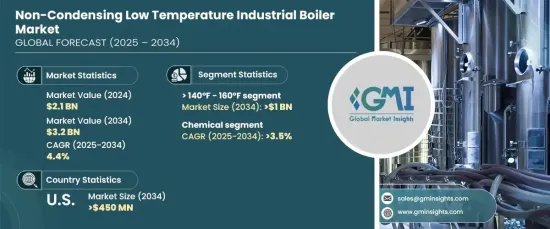
세계의 비응축식 저온 산업용 보일러 시장은 2024년에 21억 달러로 평가되었고, 2025년부터 2034년까지 CAGR 4.4%를 나타낼 것으로 예측됩니다. 이 성장의 원동력이 되는 것은 노후화된 산업 시스템의 현대화 및 보일러 인프라의 전략적 업그레이드입니다. 에너지 효율적인 기술에 대한 투자와 내구성 및 내식성이 우수한 부품의 통합이 산업의 낙관적인 전망에 기여하고 있습니다.

140-160°F의 온도 범위는 2034년까지 10억 달러의 매출이 될 것으로 예상됩니다. 이 부문의 성장을 견인하는 것은 정련소, 식품 가공, 화학 제조 등 정밀한 온도 제어가 필요한 부문에서의 사용입니다. 이 범위의 비응축 보일러는 엄격한 조건에서 최적의 작동 효율과 안정적인 성능을 발휘하도록 설계되었습니다. 제조업체 각 회사는 제품의 수명을 연장하기 위해 고급 소재와 혁신적인 디자인을 활용하여 내구성을 높이는 데 점점 더 많은 노력을 기울이고 있습니다. 사물인터넷(IoT) 지원 원격 모니터링과 예지보전시스템의 통합은 다운타임 감소, 운영 최적화, 산업 전반에 걸친 이러한 시스템의 채택 확대를 더욱 기대합니다.
| 시장 범위 | |
|---|---|
| 시작 연도 | 2024년 |
| 예측 연도 | 2025-2034년 |
| 시작 금액 | 21억 달러 |
| 예측 금액 | 32억 달러 |
| CAGR | 4.4% |
화학부문은 2034년까지 3.5%의 성장률을 유지할 전망입니다. 이 성장의 원동력이 되고 있는 것은 배출량의 삭감과 에너지 관리의 개선을 목적으로 한 엄격한 환경 규제의 도입 증가입니다. 최신 산업용 보일러는 현재 첨단 안전 기술, 자동 종료 기능, 실시간 모니터링 기능을 갖추고 엄격한 규제 기준을 준수합니다. 특히 의약품, 농약, 특수화학 등 산업에서의 화학제품 수요 증가도 이 부문의 확대에 기여하고 있습니다. 이것은 화학 산업에서 효율적이고 친환경 가열 솔루션에 대한 의존도가 높아지고 있음을 보여줍니다.
미국의 비응축식 저온 산업용 보일러 시장은 2034년까지 4억 5,000만 달러를 창출할 것으로 예측됩니다. 신뢰성이 높고 비용 효율적인 난방 시스템에 대한 수요 증가가 진행 중인 산업 확대와 함께 시장 전망을 뒷받침하고 있습니다. 미국 환경보호청(EPA)과 주정부 당국이 정한 엄격한 배출규제는 열전달 효율을 향상시키고 배출을 삭감하는 보다 선진적 시스템의 채용을 산업에 촉구하고 있습니다. 또한 기존의 난방 시스템의 현대화와 유지 보수가 낮고 오래 지속되는 솔루션에 중점을 둔 미국 시장 성장이 더욱 강화될 것으로 예상됩니다.
The Global Non-Condensing Low Temperature Industrial Boiler Market was valued at USD 2.1 billion in 2024 and is expected to grow at a CAGR of 4.4% from 2025 to 2034. This growth is being driven by the modernization of outdated industrial systems and strategic upgrades to boiler infrastructure. Investments in energy-efficient technologies, along with the integration of durable and corrosion-resistant components, are contributing to an optimistic outlook for the industry.

The segment for temperatures ranging from >140°F to 160°F is projected to generate USD 1 billion in revenue by 2034. The segment growth is driven by its use in sectors that require precise temperature control, such as refineries, food processing, and chemical manufacturing. Non-condensing boilers in this range are engineered to deliver optimal operational efficiency and consistent performance under demanding conditions. Manufacturers are increasingly focusing on enhancing durability by utilizing advanced materials and innovative designs to extend the lifespan of their products. The integration of Internet of Things (IoT)-enabled remote monitoring and predictive maintenance systems is further expected to reduce downtime, optimize operations, and increase the adoption of these systems across industries.
| Market Scope | |
|---|---|
| Start Year | 2024 |
| Forecast Year | 2025-2034 |
| Start Value | $2.1 Billion |
| Forecast Value | $3.2 Billion |
| CAGR | 4.4% |
The chemical sector is poised to grow at a rate of 3.5% through 2034. This growth is fueled by the increasing implementation of strict environmental regulations aimed at reducing emissions and improving energy management. Modern industrial boilers now come equipped with advanced safety technologies, automated shutdown functions, and real-time monitoring capabilities to ensure compliance with stringent regulatory standards. The growing demand for chemical products, particularly in industries such as pharmaceuticals, agrochemicals, and specialty chemicals, is also contributing to the sector's expansion. This demonstrates the rising dependence on efficient and environmentally friendly heating solutions within the chemical industry.
In the United States, the non-condensing low-temperature industrial boiler market is projected to generate USD 450 million by 2034. The growing demand for reliable, cost-effective heating systems, coupled with ongoing industrial expansion, is boosting market prospects. The stringent emission regulations set by the U.S. Environmental Protection Agency (EPA) and state-level authorities are driving industries to adopt more advanced systems that improve heat transfer efficiency and reduce emissions. Additionally, the modernization of legacy heating systems, combined with a greater focus on low-maintenance, long-lasting solutions, is expected to further strengthen market growth in the U.S.